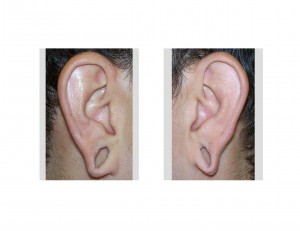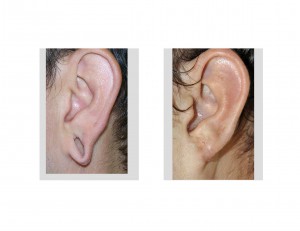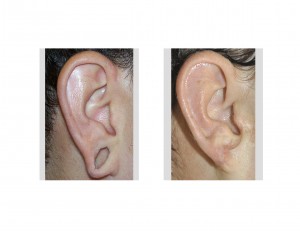Background: The adornment of the earlobe goes to back to nearly the beginning of mankind. Besides being a very visible piece of anatomy right next to the face, it is also easy to manipulate because it is composed of just skin and fat without more firm cartilage like the rest of the ear. Besides jewelry, the earlobe has been cosmetically altered by changing its shape. Making holes of various sizes in the earlobe allows for either an enlarged shape, the placement of an internal insert or both. This is done through the plastic surgery principle of tissue expansion. Known by the term of ‘gauging’, this allows the earlobe to be sequentially enlarged by gradually increasing the size of the internal insert.
Once done, the earlobe is forever altered and will always have an internal hole. Removing the inserts will allow the earlobe tissues to shrink down somewhat and the hole will always end up smaller than it was at its maximal diameter of expansion. If the hole enlargement was only fairly small (10mms or less), the hole will likely shrink to be fairly small. But larger diameters of expansion will not shrink completely back down to such a small hole. This is due to the skin being stretched beyond its elastic limits. If one is interested in reducing and reshaping their earlobe back to a more normal size and shape, surgical reconstruction will be needed.

Under local anesthesia, the holes and the excess tissue that hung down was excised. It is necessary to remove all skin that lines the enlarged hole edges. V-shaped skin flaps are designed and put together along the helical rim to prevent notching as it heals. Because he lived out of town and could not return for suture removal, it was closed with dissolveable sutures and topical glue for a dressing.

Case Highlights:
1) Large amounts of gauging or internal expansion of the earlobe will not shrink completely back down. Ideally, one should allow six months to see how the hole will ‘close’ and have the earlobe tissues return to a more normal consistency.
2) One favorable benefit of the enlarged earlobe is that there is a surplus of earlobe tissue to work with during the reconstruction. This makes for a very favorable reconstruction situation.
3) Reconstruction of the gauged earlobe can be done under local anesthesia without any real recovery. It will result in a fine line scar down through the middle of the reshaped earlobe.
Dr. Barry Eppley
Indianapolis Indiana



